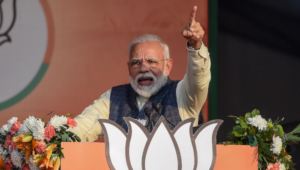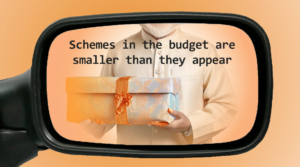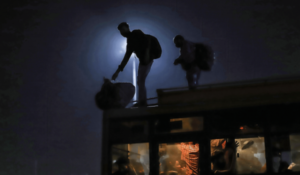P. Sainath, April 2, 2020
With his first speech on the coronavirus, Prime Minister Narendra Modi got us to scare evil spirits away by having people bang the hell out of their pots and pans.
With his second, he scared the hell out of all of us.
With not a word on how the public, particularly the poor, are to access food and other essentials in coming weeks, it sparked off a panic waiting to happen. The middle classes thronged the stores and markets – something not easy for the poor. Not for migrants leaving the cities for their villages. Not for small vendors, domestic help, agricultural labourers. Not for farmers unable to complete the rabi harvest – or stuck with it even if they have. Not for hundreds of millions of marginalised Indians.
The finance minister’s package – announced yesterday, March 26 – has this one saving grace: 5 kilos of free wheat or rice for each person for three months in addition to the 5 already given under PDS, the public distribution system. Even there – it is not at all clear if the earlier or existing 5 kilos will also be free or must be paid for. If that’s to be paid for, it won’t work. Most of the elements of the ‘package’ are sums allocated for schemes already in existence. The MGNREGA wage hike of Rs. 20 was due anyway – and where is there any mention of an additional number of days? And how if they get down to it at once, and with what kind of work, will they maintain their social distancing norms? What will people do in the many weeks it will take to roll out the scale of work needed? Will their health be up to it? We must pay MGNREGA wages daily to every labourer and farmer for as long as the crisis lasts, work or no work.
The Rs. 2,000 benefit under the PM-KISAN was already there and due – what does it add? Instead of being paid in the last month of the quarter, it is advanced to the first month. Nowhere did the finance minister give a clear break up of the Rs. 1.7 lakh crores package responding to the pandemic and for the lockdowns – what are its new elements? What part of this sum is old or existing schemes recobbled together to make the numbers? Those hardly qualify as emergency measures. Further, pensioners, widows and the disabled will get a one-time amount of Rs. 1,000 in two instalments over the next three months? And 20 crore women with Jan Dhan Yojana accounts will get Rs. 500 each for three months? That’s worse than tokenist, it’s obscene.
How will raising loan limits for self-help groups (SHGs) change a situation where getting an existing loan amount is a nightmare? And how exactly will this ‘package’ help those countless migrant workers stranded far away, trying to return to their home villages? The claim that it will help migrants is unsubstantiated. If the failure to produce a serious set of emergency measures is alarming, the attitude of the packagers is terrifying. They seem clueless on the kind of situation developing on the ground.
Lockdowns of the kind we are into – with no serious social support or planning for the vulnerable –can lead, already have led, to reverse migrations. It is impossible to get a fix on the extent or intensity of those. But reports from several states suggest that large numbers of people are heading back towards their villages as the cities and towns they work in go into a lockdown.
Many are using the only transportation now available – their own feet. Some are cycling home. Several find themselves stranded midway when trains, buses and vans stop functioning. It’s scary, the kind of hell that might break loose if this intensifies.
Imagine large groups walking home, from cities in Gujarat to villages in Rajasthan; from Hyderabad to far-flung villages of Telangana and Andhra Pradesh; from Delhi to places in Uttar Pradesh, even Bihar; from Mumbai to no-one-knows-how-many destinations. If they receive no succour, their rapidly diminishing access to food and water could trigger a catastrophe. They might fall to age-old diseases like diarrhoea, cholera and other.
Besides, the kind of situation that could build up with this mounting economic distress would see those deaths very largely amongst the working and younger populations. As Prof. T. Sundararaman, global coordinator of the People’s Health Movement, pointed out to PARI, health services – so, along with this economic distress, we may end up substituting deaths from other diseases for coronavirus deaths.”
The 8 per cent of the population in their 60s and above are most at risk from the coronavirus. The outbreak of other diseases, along with decreased access to and curtailment of other essential health services, could see working age people and the younger population taking a huge hit.”
Dr. Sundararaman, a former executive director of the National Health Systems Resources Centre, asserts there is a desperate need to “identify and act on the reverse migrations problem and the loss of livelihoods. Failing that, deaths from diseases that have long tormented mostly poor Indians could outstrip those brought about by the corona virus.” Particularly if reverse migration grows – with migrant workers in the cities gripped by hunger, failing to receive even their meagre wages.
Many migrants live on their worksites. As the sites shut down, and they’re asked to leave – where will they go? Not all of them can walk gigantic distances. They have no ration cards – how will you reach food to them?
The economic distress is already picking up speed.
What’s also surfacing is demonisation of migrant labourers, domestic workers, slum-dwellers, and other poor by housing societies convinced that they are THE problem. The truth: the carriers of COVID-19, as also of SARS earlier, are the flying classes: us. Rather than recognise that, it seems we are trying to sanitise the cities by purging them of these undesirable elements. Consider this: if our flying carriers have passed on the infection to any of those returning migrants – what could be the outcome when they reach their villages?
There have always been some migrant labourers walking back to their villages, if those were in the same or neighbouring states. The traditional way was to work at tea stalls and dhabas along the route to earn their meals – sleeping there at night. Now, with most of those shut down – what happens?
Somehow, the better off and middle classes seem convinced that if we stay at home and practise social distancing, all will be well. That, at least, we will be insulated from the virus. There is no recognition of how the economic distress will work its way back to us. For several, ‘social distancing’ resonates differently. We invented its most powerful form nearly two millennia ago – caste. Class and caste factors seem embedded in our kind of lockdown response.
It doesn’t seem to matter to us as a nation that close to a quarter of a million Indians die of tubercolosis each year. Or that diarrhoea claims up to 100,000 children’s lives annually. They aren’t us. Panic sets in when the Beautiful People find they have no immunity to some deadly diseases. So it was with SARS. So it was with the plague in Surat in 1994. Both were terrible diseases but killed far fewer people in India than they might have. But they did get a lot of attention. As I wrote at the time on Surat: “Plague germs are notorious for their non-observance of class distinctions…. worse still, they can board aircraft and fly club class to New York.”
We need to act right now. It’s not just one virus we’re fighting – pandemics are also a ‘package.’ Of which economic distress can be a self-inflicted or self-aggravated part – driving us from calamity to catastrophe
The idea that we’re fighting just one virus, and all will be fine once we’re on top of it – is dangerous. Sure, we need to fight COVID-19 desperately – this could be the worst pandemic ever since 1918 and the misnamed ‘Spanish Flu.’ (India lost between 16-21 million lives to that between 1918-21. In fact, the 1921 Census remains the only one ever to record a net reduction in the rural population).
But focusing on COVID-19 to the exclusion of the larger canvas – that’s attempting to mop the floor dry with all the taps open and running. We need an approach which pushes ideas that strengthen public health systems, rights and entitlements.
In 1978, some great minds in the field of health drew up the Declaration of Alma Ata – in days when the WHO had not been brought to heel by western government-backed corporate interests. It was that declaration which made famous the phrase ‘Health for All by 2000’. Something it believed all people of the world could attain “through a fuller and better use of the world’s resources…”
And from the ’80s, the idea of understanding the social and economic determinants of health was growing. But another idea, too was growing. More rapidly: Neoliberalism.
From the late ’80s and the ’90s, the idea of health, education, employment – as human rights was trashed worldwide.
With the mid-1990s came the globalisation of communicable diseases. But instead of building universal health systems to meet this deadly challenge, many nations further privatised their health sectors. In India, it was always private dominance. We have one of the lowest health expenditures – barely 1.2 per cent (as share of GDP) – in the world. From the 1990s, the public health system, never terribly strong, was further weakened by deliberate policy-driven measures. The present government is inviting private management takeover of even district-level hospitals.
Health expenditures across India today are possibly the fastest growing component of rural family debt. In June 2018, the Public Health Foundation of India, analysing diverse data sets on health, concluded that 55 million people had been pushed into poverty in the single year of 2011-12, because of having to fund their own health issues – it also said 38 million of these had fallen below the poverty line due to spending on medicines alone.
One of the most striking common features among many thousands of households hit by farmers’ suicides across India is this: outrageous health expenditures, often funded by borrowing from the sahucar.
We have the largest population that is least equipped to cope with a crisis like COVID-19. And here’s the tragedy: there will be COVIDS by other names in coming years. Since the late ’90s we have seen SARS and MERS (both also from coronaviruses) and other global-spread diseases. In India in 1994, we had the plague in Surat. All signals of what was to come, of the kind of world we’d built and entered.
As Prof. Dennis Carroll of the Global Virome Project recently put it: “We’ve penetrated deeper into ecozones we’ve not occupied before….” Activities like oil and mineral extraction in areas earlier having few human populations, he says, have come at a price. Our incursion into fragile ecosystems have triggered not just changes in climate but potential health disasters as wildlife-human contact increase the potential for the spread of infection, of viruses we know little or nothing about.
So yes, we’re going to see more of these.
As for COVID-19, there are two ways this can go.
The virus mutates (to our advantage) and dies out in weeks.
Or: it mutates to its own advantage, worsening the trend. That happens, all hell breaks loose.
What can we do? I make the following suggestions – over and above, or alongside and in concurrence with, some of those already put forward by some of the finest minds amongst India’s activists and intellectuals. (There are also ideas that consider measures in a larger global context of debt, privatisation and financial market failure). And accepting as inspirational, some of the measures announced by the Kerala government.
The very first thing that needs doing: preparing for emergency distribution of our close to 60 million tons of ‘surplus’ foodgrain stocks. And reaching out at once to the millions of migrant workers and other poor devastated by this crisis. Declare all presently shut community spaces (schools, colleges, community halls and buildings) to be shelters for stranded migrants and the homeless.
The second – equally important – is to get all farmers to grow food crops in the kharif season. If the present trend persists, a terrible food situation looms. They will not be able to sell cash crops they harvest this season. Going in for more cash crops could prove fatal. A vaccine/cure for the coronavirus seems many months away. Meanwhile food stocks will dwindle.
Governments must help, pick up and buy big time, the produce of farmers. Many have been unable to complete the rabi harvest – social distancing and lockdowns being in force. Those who have, can’t transport or sell it anywhere. Even for food crop production in the kharif, farmers will need an ecosystem of inputs, support services and marketing assistance.
The government must be prepared to nationalise private medical facilities across the country. Advising hospitals to have a ‘corona corner’ – so to speak – within themselves, simply won’t cut it. Spain last week nationalised all its hospitals and healthcare providers recognising that a profit-driven system can’t meet this crisis.
Sanitation workers – safai karamcharis – must be immediately regularised as fulltime employees of the governments / municipalities employing them, with Rs. 5,000 a month added to their existing salaries, and with full medical benefits they have always been denied. And supplied protective gear that they’ve never been given. We spent three decades further devastating millions of already vulnerable sanitation workers, shutting them out of public service, outsourcing their jobs to private entities – who then re-employed the same workers on contract, at lower wages and with no benefits.
Declare and rush free rations for three months to the poor.
Immediately regularise ASHA, anganwadi and mid-day meal workers – already on the frontlines of the battle – as government employees. The health and lives of India’s children are in their hands. They too must be made full employees, provided proper wages, given protective gear.
Give MGNREGA wages daily to farmers and labourers till the crisis tides over. Urban daily wagers to get Rs. 6,000 a month in the same period.
We need to get down to these measures right now. The government’s ‘package’ is a curious blend of callousness and cluelessness. It’s not just one virus we’re fighting – pandemics are also a ‘package.’ Of which economic distress can be a self-inflicted or self-aggravated part – driving us from calamity to catastrophe.
If the virus trend persists for the next two weeks, urging farmers to grow food crops for the kharif season becomes the single most important thing to do.
At the same time, can we be detached enough to see COVID-19 as a spectacularly revelatory moment in history? A junction from where we decide which way to go. A moment to renew and pursue debates on Inequality and Health Justice.
(P. Sainath is Founder Editor of the People’s Archive of Rural India. He has been a rural reporter for decades and is the author of ‘Everybody Loves a Good Drought’.)




